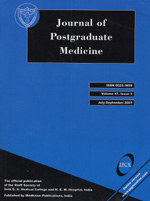
|
Journal of Postgraduate Medicine
Medknow Publications and Staff Society of Seth GS Medical College and KEM Hospital, Mumbai, India
ISSN: 0022-3859
EISSN: 0022-3859
Vol. 57, No. 3, 2011, pp. 201-205
|
 Bioline Code: jp11054
Bioline Code: jp11054
Full paper language: English
Document type: Research Article
Document available free of charge
|
|
|
Journal of Postgraduate Medicine, Vol. 57, No. 3, 2011, pp. 201-205
| en |
Polymorphisms of the gamma crystallin A and B genes among Indian patients with pediatric cataract
Mehra, S; Kapur, S & Vasavada, A R.
Abstract
Background: Previous familial studies have reported co-segregation of mutation in gamma crystallin A and B CRYGA and CRYGB genes with childhood cataract.
Aim: We investigated association of nucleotide variations in these genes in subjects with and without pediatric cataract from India.
Settings and Design: The study included 195 pediatric subjects including healthy children with no ocular defects and pediatric cataract cases.
Materials and Methods: Subjects were genotyped by PCR-RFLP method for exonic and intronic genetic variations in CRYGA and CRYGB.
Statistical Analysis: The association of these polymorphisms with cataract was estimated by two way contingency tables and the risk allele was also analyzed for their functional impact using in silico tools.
Results: No significant difference was observed between cases and control subjects for the frequencies of SNPs G198A (Intron A), T196C (Exon 3) of CRYGA and G449T(Exon 2) of CRYGB gene. -47C allele of rs2289917 in CRYGB showed the strongest association with cataract (Odd Ratio-OR=3.34, 95% Confidence Interval-CI 95% =1.82-6.12, P=0.00007). In silico analyses revealed that this polymorphism lies in a phylogenetically conserved region and impacts binding of a transcription factor, viz. progesterone receptor (PR) to CRYGB promoter.
Conclusion: rs2289917 risk allele showed a strong association with increased vulnerability for pediatric cataract. The findings suggest that this association may be a secondary phenomenon related to genetic variation playing critical role in lens development during perinatal and/or pediatric growth. Present exploratory study provides a basis for further defining the role of PR as a regulator of CRYG locus in lens formation/transparency.
Keywords
Cataract, CRYGA gene, CRYGB gene, gender, PCR-RFLP, progesterone receptor
|
| |
© Copyright 2011 Journal of Postgraduate Medicine.
Alternative site location: http://www.jpgmonline.com
|
|
